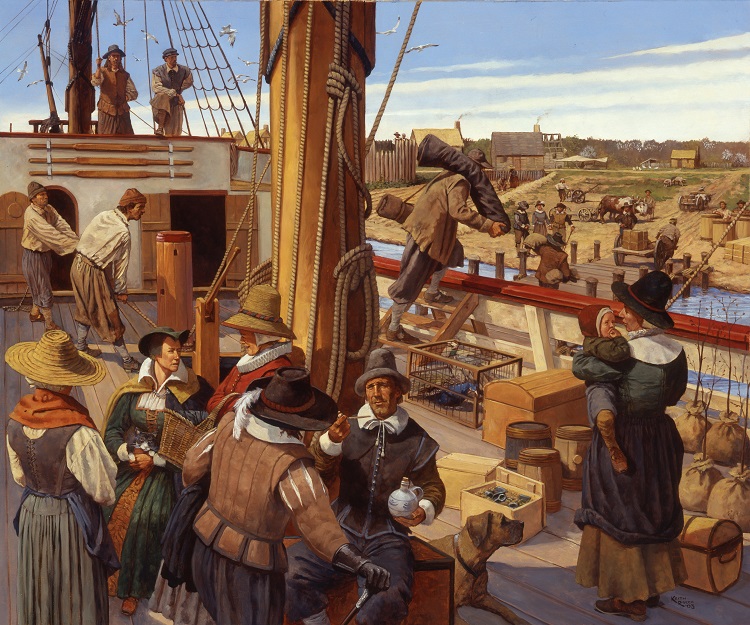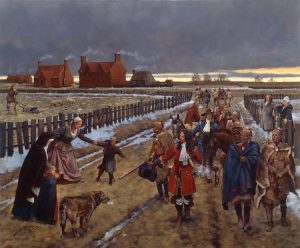Jamestown, Virginia 1620s
Description
50 signed and numbered prints
THE LURE OF VIRGINIA – GOD, GLORY, AND GOLD: These were the forces that lured the first English settlers in 1606 to the new and untamed wilderness of Virginia. They carried with them the Church of England and the hopes to convert the Native Americans to Protestant Christianity. Some desired to find its fabled gold and riches and others longed to discover a northwest passage to the treasures of the Orient.
INITIAL LACK OF WOMEN: The settlers were directed by the Virginia Company of London, a joint-stock commercial organization. The company’s charter provided the rights of trade, exploration and settlement in Virginia. The first settlers that established Jamestown in 1607 were all male; the omission of women in the first group of settlers may simply mean that they were not, as yet, necessary.
REASONS BEHIND DELAY: The company’s first priority in Virginia was possibly to build an outpost, explore and determine the best use of Virginia’s resources for commercial profits. The exclusion of women in the first venture supports the possibility that it was an exploratory expedition rather than a colonizing effort.
ESTABLISHING PERMANENCY: Once the commercial resources were discovered, the company’s revenues would continue only if the outpost became permanent. For Jamestown to survive, many unstable conditions had to be overcome.
WOMEN’S INDISPENSABLE ROLE: Providing the stability needed for Jamestown’s survival was the indispensable role played by Virginia women. Their initial arrival in 1608 and throughout the next few years contributed greatly to Jamestown’s ultimate success. Lord Bacon, a member of His Majesty’s Council for Virginia, stated about 1620 that “When a plantation grows to strength, then it is time to plant with women as well as with men; that the plantation may spread into generations, and not be ever pieced from without.”
CONTRIBUTIONS OF EARLY VIRGINIA WOMEN: The first woman to foster stability in Jamestown was not an English woman but a native Virginian. Pocahontas, the daughter of Chief Powhatan, was among the first Native Americans to bring food to the early settlers. She was eventually educated and baptized in the English Religion and in 1614 married settler John Rolfe. This early Virginia woman helped create the “Peace of Pocahontas,” which for several years, appeased the clash between the two cultures.
In July 1619, settlers were granted acres of land dependent on the time and situation of their arrival. This was the beginning of private property for Virginia men. These men, however, asked that land also be allotted for their wives who were just as deserving “…because that in a newe plantation it is not knowen whether man or woman be the most necessary.”
The Virginia Company of London seemed to agree that women were indeed quite necessary. They hoped to anchor their discontented bachelors to the soil of Virginia by using women as a stabilizing factor. They ordered in 1619 that “…a fit hundredth might be sent of women, maids young and uncorrupt, to make wives to the inhabitants and by that means to make the men there more settled and less movable….” Ninety arrived in 1620 and the company records reported in May of 1622 that, “57 young maids have been sent to make wives for the planters, divers of which were well married before the coming away of the ships.”
Jamestown would not have survived as a permanent settlement without the daring women who were willing to leave behind their English homes and face the challenges of a strange new land. These women created a sense of stability in the untamed wilderness of Virginia. They helped the settlers see Virginia not just as a temporary place for profit or adventure, but as a country in which to forge a new home.
Text Credit: National Parks Service, Historic Jamestowne “The Indispensable Role of Women at Jamestown”
Additional information
| Medium | |
|---|---|
| Size | 20" x 24" |
| Type |



